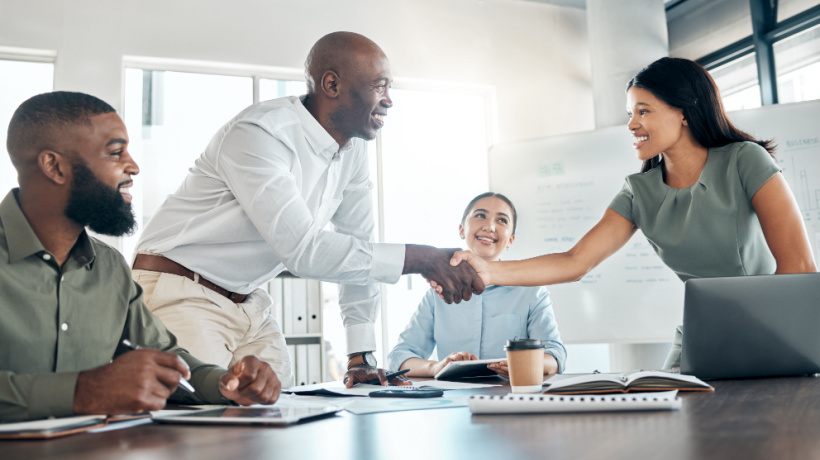All The Information You Need About Onboarding Automation
You have decided to welcome new members to your corporate family. However, the onboarding process can be long and tiring. Fortunately, onboarding automation can help you tackle tasks such as paperwork management, training, and orientation, as these can be fully automated with the right software. In the past, onboarding was carried out manually. This included HR teams preparing paperwork for new employees to complete, IT configuring computer setups, and managers organizing initial meetings. This method was often slow and chaotic, which could make new hires feel stressed and lost.
In This Guide...
- What Is Onboarding Automation?
- Onboarding Options: Manual Vs. Automated
- The Challenges Of Onboarding Employees Manually
- How To Automate Employee Onboarding
- What Are The Pros Of An Automated Onboarding Process?
- Top Practices For Successful Onboarding Automation
- Who Benefits From Automated Employee Onboarding?
What Is Onboarding Automation?
In recent years, many companies have adopted onboarding automation to streamline and enhance the onboarding process. But what does this really mean? Simply put, it involves using technology to automate and standardize the tasks and workflows of bringing new employees into the organization. Onboarding automation, combined with an onboarding checklist, also helps create a welcoming and engaging experience for new hires. A well-executed onboarding process can lead to increased job satisfaction, productivity, and retention rates. So, by using onboarding automation from day one, organizations can set the stage for long-term success and employee well-being.
Automation can also extend beyond the initial onboarding process. For example, companies can implement automated systems to deliver training materials, set goals and objectives, and conduct performance reviews. This approach not only saves time and reduces administrative burdens but also ensures that employees receive continuous support and are engaged throughout their careers. Whether you're a new hire excited to begin your journey with a company or an HR professional looking to streamline your onboarding process, onboarding automation is likely to play a key role in shaping the future of work. Let's explore this concept more and see how it benefits both companies and employees.
Onboarding Options: Manual Vs. Automated
Now that we've briefly covered onboarding automation, we need to highlight why it's preferable to manual onboarding. Manual employee onboarding can lead to several issues for both your business and the new hire. The main problem is that even creating an onboarding checklist is a time-consuming process. It requires HR staff to handle the paperwork and manage other logistical tasks, which diverts their focus from more strategic activities, like employee management and development. Additionally, the risk of human error is higher with manual onboarding, leading to inconsistencies, missed deadlines, or incomplete tasks. There's also the danger of miscommunication, which can cause confusion and frustration for new employees and harm your company's reputation. All the above can contribute to higher turnover rates, as new employees may feel disconnected from the organization.

The Challenges Of Onboarding Employees Manually
Onboarding new employees manually can be quite challenging, especially for a company that is growing and hiring multiple people at the same time. Organizations need to identify and address potential issues early in the onboarding process to avoid problems and retain their recruits. Below is a list of challenges that can arise if the process is not automated.
The Employee Onboarding Process Feels Impersonal
Generic employee onboarding experiences often overlook the individual employee's needs. All team members receive the same training plans, regardless of their unique roles or skill levels. There is also no onboarding checklist in place. This generic approach can make employees feel like they are just numbers within the system.
The Employee Experience Falters
Clerical errors and slow paperwork processing create significant challenges during initial employment. Generic training resources and inefficient administrative processes negatively impact the new employee's first impression as well. These issues can rapidly increase employee attrition rates and harm the organization's reputation.
Administrative Tasks Are Performed Slowly
Manual employee onboarding overwhelms HR teams with repetitive, time-consuming tasks. Each request and data entry needs individual handling, consuming valuable human resources. Consequently, the slow pace of administrative work creates bottlenecks in the integration process.
Vulnerable To Making Significant Mistakes
Human error is unavoidable when manually managing complex onboarding processes. Missed deadlines, incomplete documentation, and inconsistent information on onboarding checklists can create legal and operational risks for the organization.
How To Automate Employee Onboarding
Automating employee onboarding is not a new concept. If your organization wants to outperform competitors and retain top talent, follow these steps.
1. Define Pre-Onboarding Tasks
To automate employee onboarding, first identify and map all the necessary steps involved in the onboarding process. Tasks like documentation, technology access, and establishing communication touchpoints should be completed prior to the employee's start date.
2. Standardize Orientation Steps
Establish a consistent and repeatable orientation process. Develop clear guidelines and checkpoints that every new employee will follow, ensuring uniformity and thorough coverage.
3. Structure The Onboarding Workflow
Design a process that guides new employees through each stage of integration. The process should be logical and sequential, with clear timelines and accountability measures for each step.
4. Invest In The Right Software
Select onboarding platforms that offer automation, tracking, and reporting features. Opt for solutions that integrate seamlessly with your organization's HR management systems.
What Are The Pros Of An Automated Onboarding Process?
A report by CareerBuilder shows that two out of five HR managers who do not use an automated onboarding process spend three hours or more onboarding each new hire. Automating this process can greatly enhance efficiency, though. Below are the advantages of automating manual tasks such as data entry and paperwork completion.
Accuracy And Consistency
Onboarding automation helps minimize errors and inconsistencies in data entry, leading to more accurate and reliable information. Essential tasks like background checks on new employees, drug testing, and reference checks can be easily streamlined. As a result, this creates a consistent onboarding experience for all new hires and reduces the overall hiring time.
Compliance
Automation can help ensure that your company complies with many legal and regulatory requirements. Compliance is critical to avoid costly fines, penalties, or legal liabilities. For example, your onboarding platform can provide access to updated versions of legal forms and documents. Furthermore, it will help you comply with employment laws and regulations related to equal employment opportunities, anti-discrimination, and workplace safety.
Improved Engagement
Automating the onboarding process will help employees feel more connected to their workplace and colleagues by creating an engaging and interactive onboarding experience. This automation will also help the new hires better understand their role and how their contributions align with the company's overall goals and success. Additionally, new employees will have opportunities for feedback and collaboration, which can increase productivity and lead to improved company results.
Cost Savings
Onboarding automation saves time by reducing the manual processes involved in onboarding activities. This allows your HR staff to focus on more important tasks. Moreover, by offering new hires a streamlined and personalized onboarding experience, your company can keep a low turnover rate, thus reducing training costs for new hires.
Improved Data Analytics
Collecting data on the onboarding process, including completion rates and employee satisfaction, can provide your company with valuable insights into the program's effectiveness and help identify areas for improvement. Additionally, tracking and analyzing new hire productivity and performance metrics can further enhance your IT service management system.
Faster Onboarding
Automated onboarding speeds up the entire process by removing the need for manual data entry and paperwork, which can often be time-consuming and error-prone. This approach also features self-service portals and pre-built workflows to ensure that new hires complete all essential tasks and meet deadlines without missing anything.
Better Understanding Of Company Culture
With immediate access to information and resources, new hires feel more connected and confident in their roles within the organization. By collaborating with others, they will become more comfortable and gain insights into the company's culture and practices.
Reduced Stress
An automated and transparent onboarding process can reduce stress by offering continuous support and a user-friendly platform. Furthermore, automating administrative tasks such as form completion allows new hires to concentrate on more important and meaningful tasks that better prepare them for their roles.
Top Practices For Successful Onboarding Automation
Organizations can save time and money by automating onboarding tasks. According to the Society for Human Resource Management (SHRM), companies with a standardized onboarding process see that new hires are 50% more productive. Let's explore the best practices for successful onboarding automation to help your workforce operate effectively and efficiently.
Identify Goals And Objectives
What do you aim to achieve with your onboarding program? Are you looking to improve efficiency, boost engagement, reduce turnover, or ensure compliance? Understanding the answers to these questions will help you improve outcomes while lowering costs. Also, make sure that your onboarding process aligns with your company's objectives. Finally, any challenges you face, explore how automation can address them.
Create A Clear Plan
An onboarding plan outlines the steps for welcoming new employees, starting from their first day on the job and continuing until they are fully integrated into the company. This plan typically includes a detailed timeline to ensure that everyone involved in the onboarding process understands their responsibilities and deadlines. Your plan should also include the required paperwork, along with instructions on how to complete each form and where to submit it. Plus, it's important to maintain a communication plan to keep new hires informed throughout the process. Having a clear understanding of the steps you will automate helps reduce confusion, delays, and errors, which can jeopardize your goals.
Make It Engaging
Incorporating multimedia elements such as videos, images, and games can help engage your new team members from day one. It's crucial that your content is interactive and includes a reward system to motivate your new hires. Furthermore, provide clear instructions and expectations, along with all necessary resources. These can include a digital library, industry reports, or case studies.
Assign Mentors To New Hires
Your HR team can't monitor every process, even if it's automated. To support new hires, assign a mentor to each one to monitor their progress using the automation software. This way, new employees will know that they have someone they can turn to for questions or concerns. The mentor should have experience in the same role and focus on actively listening, providing constructive feedback, and helping with individual goal-setting.
Create Role-Specific Training Paths
One of the top practices that really make a difference is building role-specific training paths through your LMS. For example, if you're hiring two people for two different roles simultaneously, their tasks aren't the same, although they'll both need to learn about your company culture, values, and policies. So, you need role-specific training for each one. It may sound complicated, but with an LMS, you can create unique learning paths tailored to each role. Once you assign someone their role, the LMS can instantly deliver their personalized onboarding program, without manually sending docs or contacting them constantly for training completion.
Try AI Chatbots For 24/7 Support
AI-powered chatbots are perfect for onboarding. Usually, new hires have many questions, like "Where do I find my login credentials?" or "How do I request time off?" Instead of waiting hours for a response from HR, a chatbot can answer those questions instantly, 24/7. This gives new employees the confidence to navigate their first days more easily. Plus, chatbots are there all the time, no matter different time zones. So, whether an employee lives on the other side of the planet or catches up on training at night, they'll always have support.
Leverage Technology
There are various automation tools available, such as chatbots and Virtual Reality (VR). For instance, chatbots can serve as an FAQ system to assist new hires during their onboarding process. They can be programmed to answer frequently asked questions and provide links to relevant resources. Additionally, chatbots can help schedule meetings and appointments to ensure that everyone involved in the onboarding process stays organized and on track.
Make The Process Consistent
To ensure consistency, develop standard operating procedures that outline who's responsible for each task and the timeline for completion. Furthermore, it's important for new hires to understand what to expect during the onboarding process. The most critical aspect of maintaining consistency, though, is to use a centralized onboarding platform, which guarantees that all new hires receive the same onboarding experience.
Measure And Analyze Results
Establishing Key Performance Indicators (KPIs) can help organizations track and measure the success of their onboarding process. KPIs may include productivity, retention rates, and satisfaction scores. Data analytics tools can then be utilized to monitor task and form completion, the overall time taken to finish the process, and the success rates of new hires. By doing this, you can identify areas that need improvement and make the necessary changes promptly.
Gather Feedback From New Hires
Use surveys and questionnaires to gather feedback from your new employees. These can be done digitally, through an online platform or email, or in person. Surveys may include questions about the clarity of communication, the quality of training, and the overall experience. You can also gather insights through one-on-one meetings with managers or HR representatives. Ask your new hires about their experiences, including what went well or what could be improved. Finally, conduct frequent check-ins and follow-ups to see how your new employees are progressing and determine if they need additional training to enhance their performance, even when implementing employee onboarding automation.
Who Benefits From Automated Employee Onboarding?
Automating the onboarding process for new employees benefits both recruits and existing staff. Let's explore how.
Accounting Departments
The accounting department streamlines the payroll setup process and manages tax documentation along with other financial onboarding procedures with minimal manual intervention.
IT Teams
IT teams automate system access, oversee equipment provisioning, and implement security protocols for new team members.
Company Management And Leaders
Management teams require real-time insights into onboarding data. They utilize analytics to monitor the effectiveness and efficiency of the onboarding process.
Customer Service Departments
These teams focus on providing faster and more consistent training and resource allocation for new employees who interact with customers.
Conclusion
Successful employee onboarding automation enhances both productivity and employee satisfaction. By following best practices, companies can improve the overall onboarding experience and ensure new hires are set up for success. With ongoing technological advancements, it is essential for every organization to prioritize the automation of its onboarding process. This not only benefits new team members but also supports HR and Learning & Development (L&D) departments. Finally, take a look at our list of top onboarding Learning Management System (LMS) platforms to review vendors and find the right tools for your new hire training programs.
Frequently Asked Questions
When the onboarding process changes, especially with automation, it’s normal to have questions. Here are some FAQs and their answers.
You can automate employee onboarding by utilizing specialized HR software, creating standardized workflows, implementing digital content management, and establishing automated communication protocols.
The Five Cs of onboarding are Compliance, Clarification, Culture, Connection, and Check-back. This framework is super helpful for successfully integrating new employees.
While automation is really useful, it’s important to find a balance. For the best results, combine the efficiency of technology with a personal touch to make the experience feel more tailored.
Automating repetitive tasks such as sending welcome emails, collecting documents, assigning training, and scheduling check-ins save a significant amount of time and ensures consistency. Even these small tasks have a significant impact, as new hires feel supported from the very beginning, allowing HR teams to concentrate on people, not paperwork.
AI-powered chatbots make onboarding easier by instantly answering common new hire questions, like where to find forms or how to access tools, at any time of day. They reduce confusion, speed things up, and free up HR teams to connect more with new hires when welcoming them.
To create role-specific training paths in an LMS, just group content based on job roles, such as sales, marketing, or tech. Then, assign each group its own onboarding track. Most LMS platforms let you automate this so new hires get only the training they need. This way, the process becomes efficient, personalized, and easy to manage.
Even with automation, you can still make onboarding feel personal. Add welcome videos from team members, send a personalized email on Day 1, and schedule real-time check-ins. Automation handles the routine stuff, so you can focus on making newcomers feel truly valued and included.










